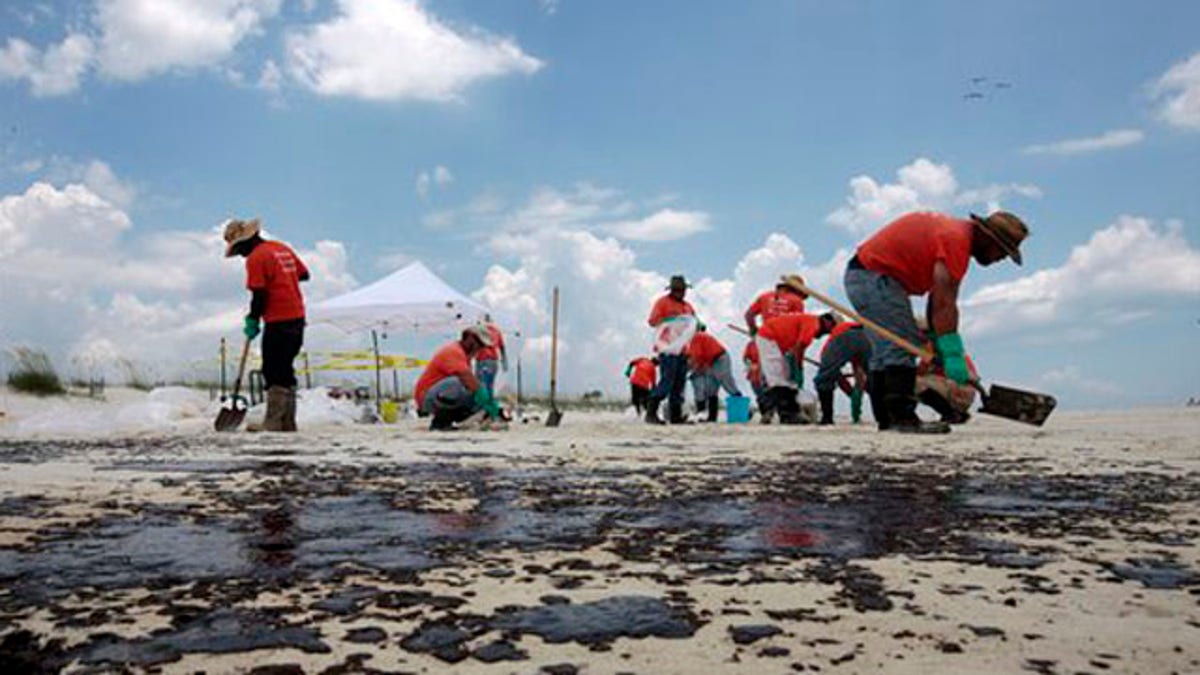
Oil cleanup workers hired by BP pick up oil on the beach in Gulf Shores, Ala., July 2. (AP Photo)
The Obama administration cast doubt Thursday on BP's assertion that it could potentially plug the blown-out well in the Gulf of Mexico by the end of July, weeks ahead of schedule.
The BP official who offered that estimate, in an interview with The Wall Street Journal, described it as a "perfect world" scenario. Bob Dudley, head of the firm's Gulf Coast restoration unit, said "it's possible" to stop the well between July 20 and July 27, well ahead of the mid-August target.
Asked about the projection Thursday, a senior Obama administration official was highly skeptical.
"I don't think at this time, you know, we think that that is a reasonable expectation of the date," the official said.
Even Dudley acknowledged the scenario was "unlikely." Officials generally said the relief well being drilled deep into the sea floor of the Gulf of Mexico to shut down the gushing well could be completed ahead of schedule only if conditions are ideal.
The relief well is currently the best hope for stanching the oil leak set off by the April 20 explosion aboard the Deepwater Horizon drilling rig, which killed 11 workers and began an environmental catastrophe for the region.
National Incident Commander and retired Coast Guard Adm. Thad Allen said Thursday that the relief well is expected to intercept and penetrate the Deepwater Horizon well pipe about 18,000 feet below sea level within seven to 10 days.
The administration is currently evaluating a plan BP has outlined to put a tighter cap on the leak and replace one of two vessels siphoning oil, senior officials said. They have an eight-day window before bad weather is expected.
The plan would be to remove the oil-collecting ship Discover Enterprise, which is now capturing 15,000 barrels a day, and replace it with another vessel, the Helix, which can capture 25,000 barrels a day.
At the same time, BP would be trying to replace the cap with a tighter seal. The new cap would allow more boats to hook up and could eventually increase collection to about 80,000 barrels a day.
But they won't know how long it will take to stop the oil until they get there. The gushing well has several concentric rings, and oil could be coming up through multiple rings, Allen said.
The plan is to pump heavy mud and then cement into the well to overcome the upward pressure of the huge oil reservoir below. If the oil is coming through the outer ring of the well, then they will have to pump in mud and cement to stop that layer first. Then they would have to drill through the hardened cement and repeat the process in each ring until they reach the center pipe and do it again.
That scenario would push into the middle of August, which is the timeline the company and government officials have held to for weeks.
If the oil is only coming up the center pipe, then it's possible to stop the leak sooner.
"We're a bit ahead of schedule, but it just takes one storm to change that," BP spokesman Scott Dean said.
Shaving even days off the timeline would stop millions of gallons of oil from escaping into the Gulf. The broken well has spewed between 86 million and 169 million gallons of oil, according to federal estimates. That's enough oil to fill about 3.4 million standard bathtubs.
The Associated Press contributed to this report.




